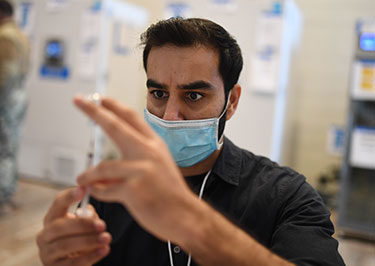While people of color in the U.S. are at high risk for COVID-19, they are not the ones getting the most vaccinations. As of April 15, whites accounted for two-thirds of people who had received at least one dose of a COVID-19 vaccine, according to the Centers for Disease Control and Prevention. Among vaccine recipients whose race and ethnicity were known, about 11% were Hispanic, 8% were Black, 5% were Asian and 1% were American Indian or Alaska Native.
Early on, some of those numbers could be explained in part by the makeup of the U.S. health workforce, which was prioritized for early vaccinations and is primarily white. But the vaccination percentages do not line up with the fact that minorities are at higher risk for COVID-19 infection, hospitalization and death than whites.
 That disparity has led two states to prioritize people of color for vaccination this year. In January, Montana announced it was prioritizing American Indians and other minority groups for COVID-19 vaccination. On April 7, Vermont began prioritizing Black adults and other people of color for COVID-19 vaccinations, citing trailing vaccination rates.
That disparity has led two states to prioritize people of color for vaccination this year. In January, Montana announced it was prioritizing American Indians and other minority groups for COVID-19 vaccination. On April 7, Vermont began prioritizing Black adults and other people of color for COVID-19 vaccinations, citing trailing vaccination rates.
“It is unacceptable that this disparity remains for this population,” Mark Levine, MD, Vermont’s health commissioner, said during a news conference announcing the decision.
Examining prioritization tactics
While public health has long prioritized vaccinations by risk, particularly for older adults and children, doing it specifically by race and ethnicity is less common.
Both CDC and the National Academies of Sciences, Engineering and Medicine included social determinants of health in their 2020 recommendations for prioritization of COVID-19 vaccines. NASEM, for example, recommended targeting highly vulnerable people, which “would incorporate the variables that the committee believes are most linked to the disproportionate impact of COVID-19 on people of color.”
By doing so, minority groups are brought into the vaccination-priority pool, according to Akilah Jefferson, MD, MSc, a bioethicist and an assistant professor in the Allergy and Immunology Division at the University of Arkansas for Medical Sciences’ College of Medicine.
“If we are prioritizing people who are most vulnerable, which we can identify in this pandemic generally as front-line workers...you tend to start skewing toward populations you can identify by race or ethnicity,” Jefferson told The Nation’s Health. “There are ways that by prioritizing the most vulnerable, you pick up some of these groups without explicitly saying ‘we are going to give it to Black people first, Hispanic people first, Indigenous people first.’”
The disparity between white and minority groups receiving COVID-19 vaccinations in the U.S. shows that a lot of work needs to be done to get all people who want a vaccination access, Jefferson said. If not, many people of color will likely be left behind, with dire consequences for health.
Risk, not race, should determine who is prioritized for COVID-19 vaccinations, according to APHA Executive Director Georges Benjamin, MD. By prioritizing by race or ethnicity, some people would be vaccinated who are not at high risk, he said. For example, Black or Hispanic professionals working from home during the pandemic may be at low risk, yet they would be first in line for vaccination.
“We always say you should do this by risk,” Benjamin told The Nation’s Health. “Because when you do it by race, you are profiling people, you are stigmatizing them based on race. You are saying, ‘Black people are much more likely to get the disease because they are Black, not because they have situations in which they are much more at risk.’”
Legal challenges may not stand
Even if prioritizing people for vaccination by race or ethnicity is deemed ethical, it may not hold up under a legal challenge based on discrimination, according to Lawrence Gostin, JD, director of the O’Neill Institute for National and Global Health Law at Georgetown University.
“The Supreme Court, with its new conservative super-majority, would likely strike down any explicit racial preference,” Gostin told The Nation’s Health. “Conservatives believe that race should have no place in deciding government priorities, including lifesaving vaccines.”
The Supreme Court has leaned toward a “strict scrutiny” standard when considering policies that categorize populations by race or ethnicity, Gostin and co-authors noted in an October article in the Journal of the American Medical Association. Strict scrutiny means the court would need a compelling reason to set aside established law on nondiscrimination to prioritize vaccination based on race.
“You would have to prove this was the only way you could make sure you were reducing spread of the disease,” Matthew Wynia, MD, MPH, FACP, director of the Center for Bioethics and Humanities at the University of Colorado, told The Nation’s Health.
Given the potential legal hurdles, Gostin said the better path is one taken by most states: prioritizing not by race but by social determinants of health.
“I believe that using a social deprivation index is best, factoring in key social determinants like poverty, housing, education,” Gostin said. “Another way to do it is through ZIP code, favoring minority neighborhoods. Washington, D.C., has done this.”
For more on the ethics of COVID-19 vaccine prioritization, read our cover story in the April 2021 issue of The Nation's Health.
Meroz Qureshy, a CVS Health pharmacy manager, prepares a COVID-19 vaccination dose during a vaccination event at New York City’s Yankee Stadium in February. (Photo by Staff Sgt. Christopher S. Muncy, courtesy U.S. Air Force Reserve/Flickr Creative Commons)